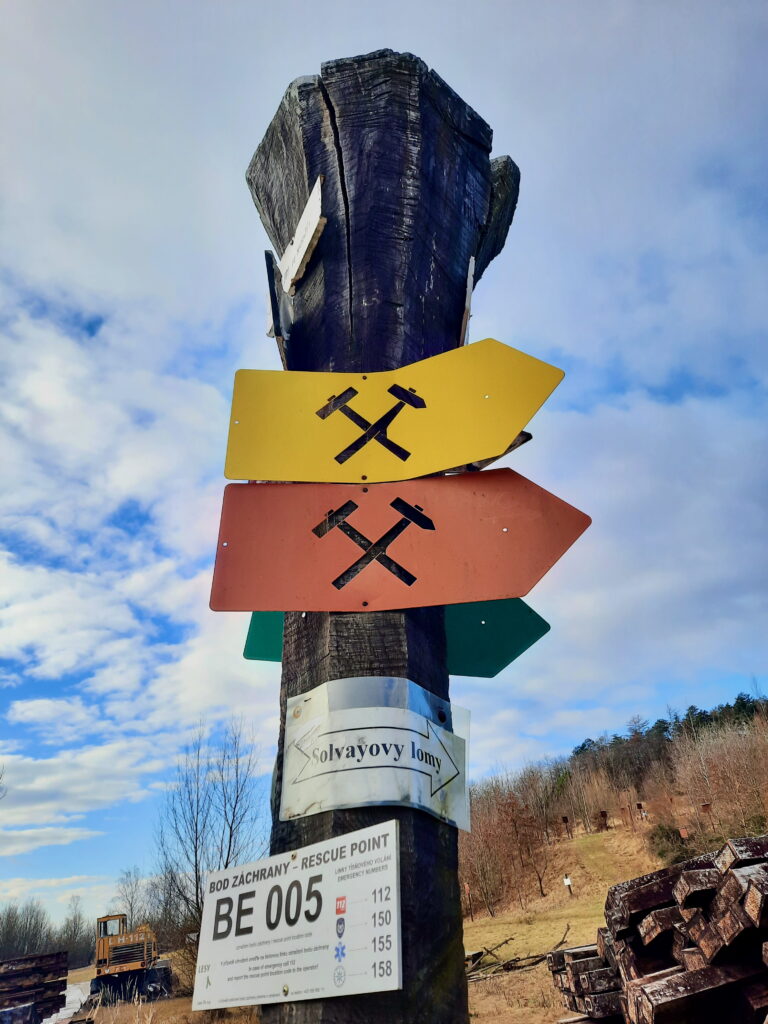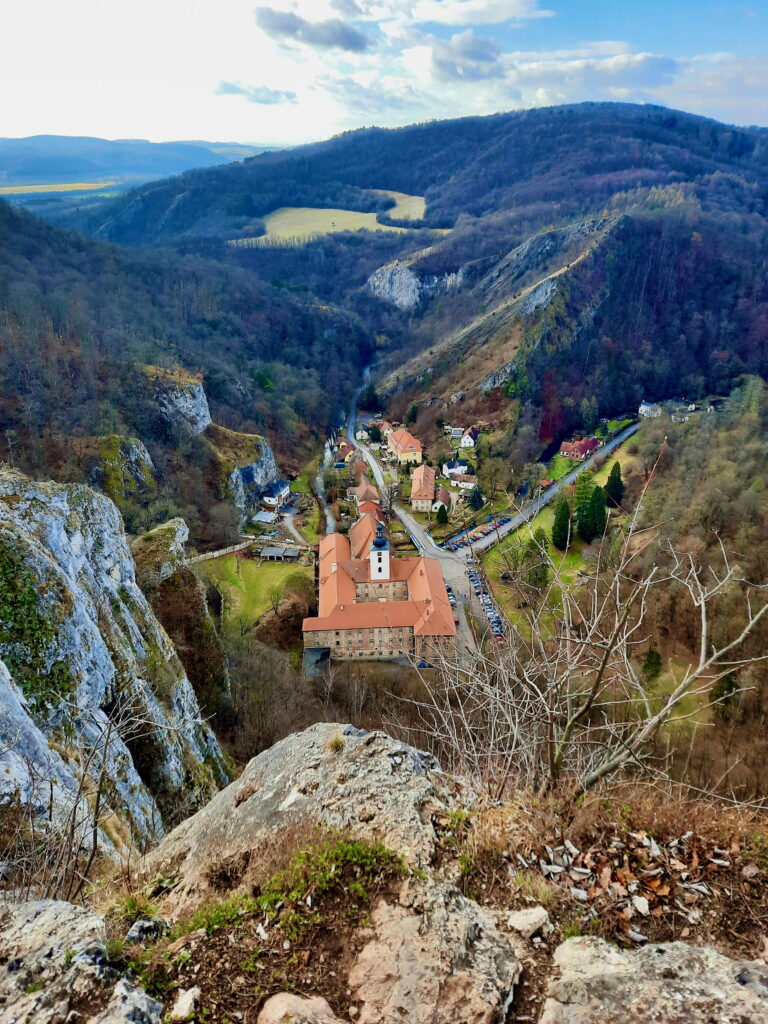Reading Time: 4 Minutes 40 Seconds
History of the Solvayovy lomy
The Solvayovy lomy are former limestone quarries located in the middle of a forest between the villages of Svatý Jan pod Skalou, Bubovice and Loděnice, about 20 km west of Prague.
Today, the area of the disused limestone quarries has been converted into an open-air museum or “skanzen”.
The museum presents the history of the extraction and transportation of limestone in the Bohemian Karst (Český Kras, in Czech).
The Solvay quarries have served as a primary source of high-quality limestone for chemical production for decades.
The quarry was created to provide limestone to a factory near Ústí nad Labem, which produced soda using the so-called Solvay process.
The Solvay company was both the owner and the operator of the quarry and today’s museum bears its name.
The concession for the construction of the quarry was granted in 1916, with mining beginning in 1918.
Initially, operations took place in a single-level quarry, which was later expanded to two levels.
The limestone extraction process
Pneumatic hammers and drills were used to break the stone. The compressors were powered first by a steam locomotive and later by a petrol engine, and provided compressed air for the pneumatic tools.
The extracted material was manually loaded into carts of a 600 mm narrow-gauge railway.
These carts transported the material to the upper station of a ropeway conveyor, which connected to the railway in Loděnice.
From there, the limestone was then transferred to the factory for processing.
The cableway spanned 1.580m in length, rose 126m in height and could transport 38 tons of material per hour.
In 1925, electricity reached the quarry.
Such event allowed to replacement of the internal combustion engine powering the compressor with an electric one, as well as the purchase of a more powerful compressor.
By 1928, the quarry was already equipped with three electric motors for a total power of 85.75 HP, and over 60 light bulbs illuminated the facility.
Limestone was initially mined by creating horizontal underground galleries beneath the deposit, but this method of extraction proved to be largely unsuccessful.
During the summer of 1926, a new quarry was opened, referred to as the Upper Quarry, now known as “Střelnice” (the shooting range).
This new quarry reached a height of 12m, allowing for the limestone to be transported out via a sloping track.
In 1929, work began on a new quarry located in an area on the opposite side of the hill, as the limestone reserves in the previous area were no longer adequate in quantity and quality.
This new site was named the Southern Quarry and it connected to the Upper Quarry by a 217m long transport tunnel.
The last years of the Solvayovy lomy
Mining continued over the years regardless of political changes, and reached its peak during World War II.
It was during this period that both the equipment and the methods of extracting and transporting limestone were expanded and modernized.
In the 1950s, the quarry was nationalized, later privatized, and changed ownership several times thereafter.
The extraction went on until the 1960s, as limestone was being utilized for road repairs.
Ultimately, in 1963 a new, more modern quarry was put into operation nearby, leading to the complete abandonment of the Solvayovy lomy.
What to see at the open-air museum
The skanzen is usually open from May to October, with some exceptional opening, for example during New Year or Easter.
Visitors can enjoy a 20-minute ride on a narrow-gauge railway along a 1.8 km circuit, as well as a visit to the museum gallery and to the shaft.
In addition, the open-air exhibition features many vehicles and objects used in the quarry, including an inclined railway track, cable excavators, and old locomotives.
Additionally, there is a café on-site, set inside an old tram.
Keep in mind that the temperature inside the underground tunnel remains constant at 8°C, therefore it is a good idea to bring warm clothing, especially if you plan to visit during the summer.

The open-air museum is managed by the Barbora Association, a society founded in 1993 to preserve mining and industrial heritage.
The members of Barbora have gradually restored the narrow-gauge railway and developed what is now officially the museum.
They are continually engaged in repairing various machines, reconstructing parts of the area, and working on development projects. Everyone is welcome to give a hand, whether physically or financially.
All the info you might need are on their official website.
How to get there
The Solvayovy lomy are located in a national nature reserve, and car access is prohibited.
You can easily reach the place by foot or by bike from one of the neighboring villages.
- From Bubovice:
You can get to Bubovice either by car or by bus 311 from Zličín.
The city hall of Bubovice created a wide parking area, which is paid (50Kč for 1.5h, 20Kč each subsequent hour).
You have a 20-minute walk completely flat from the bus stop or from the car park. - From Loděnice:
Follow the blue trail, which starts from the train station and leads up to the quarry.
Bring sturdy and comfortable shoes, because you have to walk 3.5 km with an elevation of almost 200 m.
If you don’t have a car, you can reach Loděnice either by train from Prague (lately from Praha-Zlíchov) or by buses 380 and 384 from Zličín. - From Svatý Jan pod Skalou:
This is probably the most interesting route. You first follow the red trail and then the green one.
If travelling by public transport, you must first get to Loděnice or Beroun and then take a bus from there.
If from Loděnice see above, if from Beroun the bus is 425.

You can also get to the skanzen by bike directly from your home (if you live in Prague), or take the metro to Stodůlky and start cycling from there. There are several routes to chose from and the longest is a 20km ride.
After visiting the open-air museum, you can continue your day with a hike to the cross.
From this point you have a wonderful view of the village of Svatý Jan pod Skalou and the surrounding hills.
All the hiking paths are well marked and clearly visible.
Remember to consult pubtran.cz before planning your trip.

